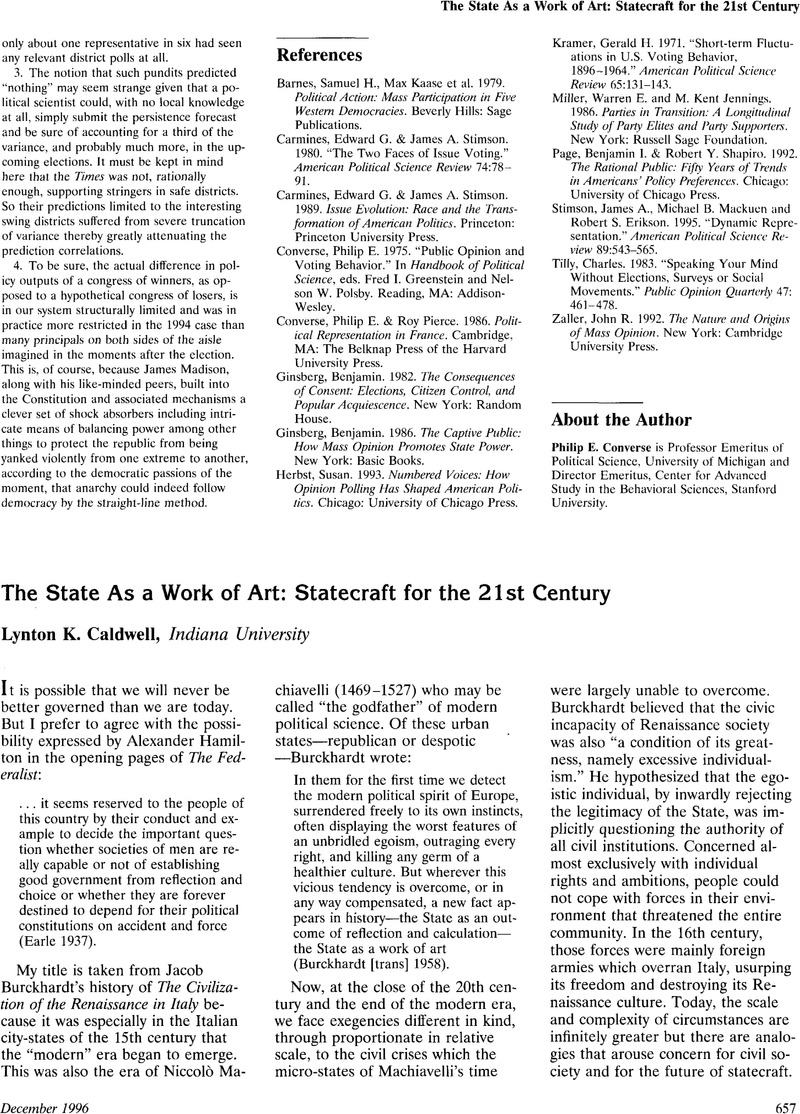No CrossRef data available.
Article contents
The State As a Work of Art: Statecraft for the 21st Century
Published online by Cambridge University Press: 02 September 2013
Abstract
An abstract is not available for this content so a preview has been provided. Please use the Get access link above for information on how to access this content.

- Type
- John Gaus Lecture
- Information
- Copyright
- Copyright © The American Political Science Association 1996
References
Almond, Gabriel A., and Verba, Sidney. 1963. The Civic Culture: Political Attitudes and Democracy in Five Nations. Princeton: Princeton University Press.CrossRefGoogle Scholar
Burckhardt, Jacob. 1958. The Civilization of Renaissance in Italy. Vol 1. Trans. Middlemore, S.G.C.. New York: Harper and Row.Google Scholar
Caldwell, Lynton Keith. 1984. The President As Convenor of interests: Policy Development for the 21st Century. Bloomington, IN: School of Public and Environmental Affairs.Google Scholar
Detmold, Christian E.
1940. Discourses on the First Ten Books of Titus Livius. Trans. New York: Modern Library.Google Scholar
Ford, P.L., ed. 1904. The Works of Thomas Jefferson. XII. New York: G.P. Putnam and Sons: 12.Google Scholar
Forrester, Jay W.
1971. “Counterintuitive Behavior of Social Systems.” Technology Review
73(3).Google Scholar
Gaus, John Merriman. 1947. Reflections on Public Administration. University, AL: University of Alabama Press.Google Scholar
Gunnell, John G.
1995. “The Declination of the ‘State’ and the Origins of American Pluralism.” In Political Science in History: Research Programs and Political Tradition, eds. Farr, James, Dryzek, John, and Leonard, Stephen T.. New York: Cambridge University Press.Google Scholar
Jouvenel, Bertrand de. 1963. “The Political Consequences of the Rise of Science.” Bulletin of the Atomic Scientists (December).Google Scholar
Krabbe, Hugo. 1922. The Modem Idea of State. Trans. Sabine, George H. and Shepard, Walter J.. The Hague: Martinus Nijhoff.CrossRefGoogle Scholar
Mansfield, Harvey C. Jr.
1979. Machiavelli's New Modes and Orders: A Study of the Discources on Livy. Ithaca, NY: Cornell University Press.Google Scholar
Michael, Donald N.
1968. The Unprepared Society: Planning for a Precarious Future. New York: Basic Books.Google Scholar
Michael, Donald N.
1993. “Governing by Learning: Boundaries, Myths and Metaphors.” Futures
25(1):81–89.CrossRefGoogle Scholar
Miller, Jon D.
1983. The American People and Science Policy: The Role of Public Attitudes in the Policy Process. New York: Pergamon Press.Google Scholar
Platt, John R. and Cellarius, Richard A.. 1972. “Councils of Urgent Studies: Coordinating Councils Could Force and Legitimize Research and Solutions of Our Major Crises.” Science
177(August):670–6776.Google Scholar
Putnam., Robert D.
1995. “Tuning In, Tuning Out: The Strange Disappearance of Social Capital in America.” PS: Political Science and Politics
28:664–683.Google Scholar
Salamon, Lester M.
1995. Partners in Public Service: Government-Non Profit Relations in the Modern Welfare State. Baltimore: Johns Hopkins University Press.CrossRefGoogle Scholar
Samuelson, Robert J.
1995. The Good Life and its Discontents: The American Dream in the Age of Entitlement, 1945–1995. New York: Times Books (Random House).Google Scholar
Sandel, Michael J.
1996. Democracy's Discontent: America in Search of a Public Philosophy. Cambridge, MA: Belnap Press of Harvard University Press.Google Scholar
Wilde, Norman. 1924. The Ethical Basis of the State. Princeton: Princeton University Press.Google Scholar


